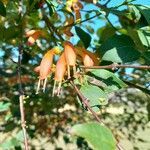Dwarf shrub, shrub or tree, up to 10 m high; glabrous. Stems multiple, branches drooping. Leaves opposite; blade ovate or elliptic, up to 90 x 50 mm, apex acute to attenuate, base asymmetrical, square or broadly tapering, margins dentate or subentire. Flowers: axillary, in dense clusters, on old wood; corolla with tube up to 40 mm long, orange-red, Apr.-Aug. Fruit oval or globose berries, black when ripe.
Evergreen, dwarf shrub to tree, up to 13 m high; often many stems and branches drooping. Leaves ovate, acuminate, margins serrulate, petiolate. Flowers in axillary clusters, mostly on old wood. Calyx cup-shaped, 3-5-lobed. Corolla up to 40 mm long, tube funnel-shaped, usually curved and mouth oblique, orange to brick-red or pink, yellow at base. Flowering time mainly July-Oct.
Leaves petiolate; lamina 4.5–10 x 2.0–6.2 cm., broadly ovate, acuminate to caudate-acuminate, rounded to broadly cuneate at base, coriaceous, shortly serrate to serrate-crenate, glabrous, minutely glandular-punctate beneath; petiole 4–12 mm. long.
Corolla orange-yellow to brownish-red, 25–33 mm. long, tube curved, widening above to 6–10 mm. diam., slightly gibbous at base minutely glandular-pubescent without, mouth oblique, unequally 4-lobed; lobes not marginally pubescent.
Glabrous shrub or tree, up to 10 m high. Leaves opposite, ovate or elliptic, up to 90 x 50 mm, dentate or subentire. Berries oval or globose. Flowers axillary, subfasciculate, corolla tube up to 30 mm long, orange-red.
Shrub or small tree to 12 m. Leaves ovate, shiny, toothed. Flowers orange or greenish yellow, corolla tubular, curved, 5-lobed.
Pedicels 10–14 mm. long with pair of bracteoles below the middle; very sparse, irregularly hirsute.
Calyx 2.4–3.5 mm. long, lobes 3.8–4.2 mm. wide, joined to beyond halfway, rounded, subglabrous.
Berry 12–18 mm. long, 8.5–14 mm. in diam., ovoid to subglobose, blackish-purple when ripe.
Small tree or erect to straggling shrub up to 12 m. tall; branches sub-quadrangular.
Bracteoles 1–1.8 x 0.4–0.5 mm., lanceolate.
Stamens long exserted.
Style 20–38 mm. long.


